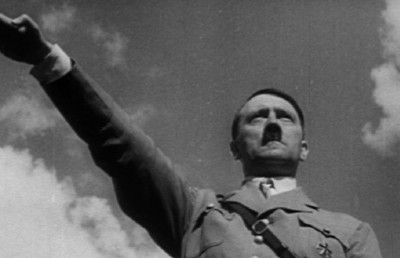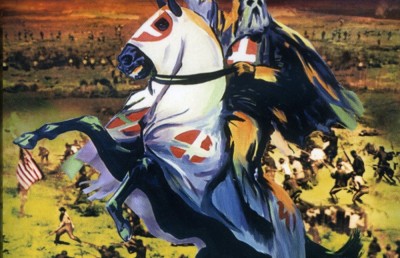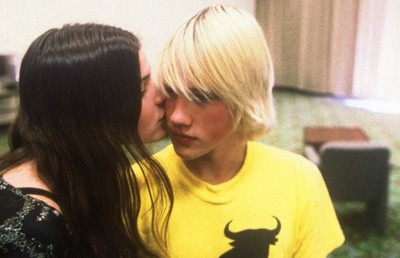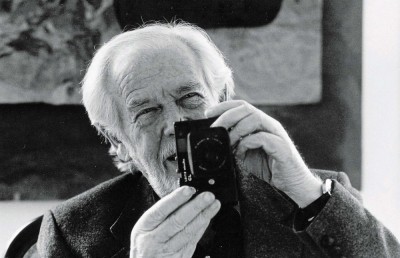Passing Through/Torn Formations and the Performative Documentary
Phil Hoffman
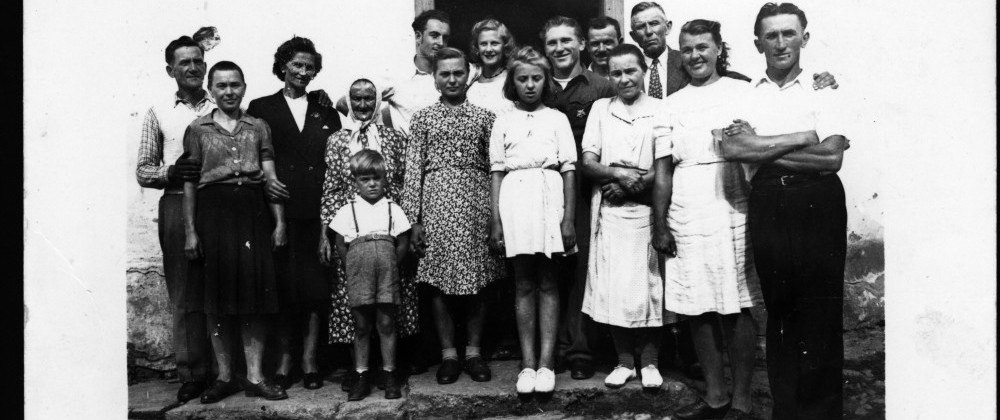
Philip Hoffman’s 1987 film passing through/torn formations originated with a 1984 voyage to Czechoslovakia to visit relatives on his mother’s side. The project evolved to include a mixture of various media. These included 16mm film from that trip, archival 8mm footage, audio recordings of family singsongs, and video of Hoffman’s mother translating audio taped messages from her Czechoslovakian aunt. The film is an attempt to transcend temporal and spatial barriers and reunite his physically and psychologically diasporic family. In an unpublished statement Hoffman explained that the film involves an uncle who, due to eccentricities and antisocial behaviour, had become a site of family discord. Hoffman infers that for these reasons he rejected conventional realist “strategies” that would further marginalize this “explosive” uncle. A realist strategy would also de-emphasize “the Family’s role in the formation of our sense of self, and self-worth”.1
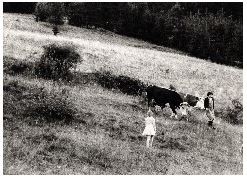
Andrea in field, 1984
Hoffman describes a strategy of narrative de-struction, an expansion outward from a conventional narrative con-struction. He intends to represent the family in such a way that the entire family shares in the tragedy. This way Hoffman does not place the film’s pathos on the back of one individual.2 He wrote:
“To more evenly distribute the weight of the family’s tragedy, and to suggest the complexity of family dynamics, the characters are constructed through a picture/sound design which offers ambiguous characterization; i.e., voice and picture are transferable amongst family members so that personalization of the problem becomes defocused. This transference of meaning is also reflected in the construction of the narrative. Scenes continually repeat themselves, each being a variation (a multiplication) of the previous scene(s). With each subsequent viewing new meaning is brought to the viewer. In this way, a labyrinth of interpretations can surface for the viewer ranging from personal to archetypal.“3
In conceiving his project this way, Hoffman was rejecting fifty years of dominant documentary forms in favour of something else – but what was this something else?
In her landmark essay “Documentary Is/Not a Name,” Trinh T. Minh-ha inferred that the very idea of documentary is such a problematical field as to become an impossible form. Nevertheless, what is a form besides agreed upon reception? If you say: “This is a documentary”, and I am inclined to agree, then it is a documentary. If I do not agree, then it is something else. Helping to make comprehensible what is seemingly incomprehensible, Bill Nichols has created a taxonomy of documentary modes of expression. The performative mode, the latest to be added to the previously articulated expository, observational, interactive and reflexive modes, declares a shift from what we have come to associate with documentary. In short, the performative documentary breaks from traditions of empirical evidence, accepted conventions of representing ‘reality’ and classical narratives structuring the elaboration of the filmic text.4 The performative documentary eschews empiricism, realism, and narrative. Instead it favours an aesthetico-temporal structure of associated but fragmentary filmic events. These events are clustered around the subjectively perceived citizenship, and both collective and individual memory. Through its expressive qualities, the performative documentary rejects any preoccupation with ontology as empirical thinking imagines it. It re-frames the profilmic event as phenomena subjectively perceived, weaving fragments of representation into an aesthetic response of knowledge and rhetorical truth.5 It is a form of aesthetic engagement with the world that supposes an ontology that transcends the empirical. As such, the performative documentary shares little resemblance to the historical world as we have to come understand it through an aesthetic stylisation generally called realism. We move from the indexical as the referent and dominant feature to arrive at a construction with elements of the expressive, the poetic and rhetorical.6 This emphatic shift accentuates the fuzzy boundary between documentary and fiction, making the spectator the primary referent, as opposed to a perceived historical world. The truth can now be found “in there” rather than “out there”.
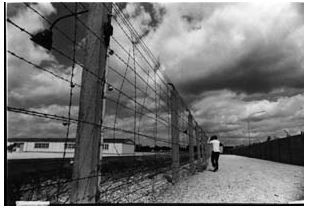
Dachau, 1984
passing through/torn formations resists classical narrative structure and its linear presumption of patterns of cause and effect. In doing so, Hoffman constructs a narrative of a different kind. It is a narrative based on association of images and sound repeated in an abstract pattern that suggests fragments of memory in a temporal dream state. Freed from the narrative line, Hoffman allows the spectator to indulge in association and memories of their own. These are possibly individual, conceivably collective, or perhaps constructed within a space between filmmaker and viewer. We can understand this as a temporal space of possible shared knowledge or private thoughts. It is a privileged space of ambiguity, not the obscurity of psychological motivation, but the abstruseness of movement across space and time. It is the ambiguity of opening possibilities of what could be rather than what might be. It is a world of possibilities in which the act of spectatorship becomes activated. Hoffman describes this formal structure as a mosaic of film conventions: “It is a matter of collecting images, sound, stories and writing about things that are happening while I’m filming, writing about the experience of watching what I get back from the lab, hearing other people and what they think about as I’m working, and incorporating that sometimes into the voice over, or re-shooting material, and gradually the form and the structure of the piece surfaces.”7 It is a way of working and a way of creating meaning that frees the spectator from the subjugation of the classical narrative. As such, it provides a space for the spectator to think and to feel. It allows the spectator to become, in a word, the referent.
The performative documentary engages the spectator with an aesthetic that de-emphasizes reference to an empirical reality. It creates subjectivity in the spectator that connects an abstract aesthetic to an ontology rooted in the abstract. As such, its ontology is an experiential truth rather than an empirical one. The expository qualities of the performative documentary seem, not so much to reject the empirical as to engage that world in a felt, experiential, poetic movement. The aesthetics of realism become fragmented and interrupted. In a broad sense, documentaries in the performative mode doubt and question realist epistemology as an inadequate means of representing the ‘real’. The unreal replaces the real as a truth claim, although a truth claim that respects the separateness of individual truths. It is, in its refusal to dictate interpretation, democratic in its meaning and its construction of significations. The spectator becomes the referent because the spectator is obliged to construct meaning out of fragmentary moments of abstract epistemology. This amounts to a gesture of self-reflexive truth.
In breaking down realist notions of ontology of the ‘real’, the performative documentary invites the spectator to look for truth inside the self. It takes reflexivity outside the text and into the spectator in a gesture of implied cogito. In this way the performative documentary proposes conditions for thought. Also, through its abstract aesthetic, it presents the spectator with the possibility of the “unthought”. Michel Foucault has described the unthought as, “in relation to man, the Other: the Other that is not only a brother but a twin, born not of man, nor in man, but beside him and at the same time in an identical newness, in an unavoidable duality”.8 Foucault saw the unthought as accompanying man since the nineteenth century, as a sort of silent companion:
“In Hegelian phenomenology it was the An sich as opposed to the Fur sich; for Schopenhauer it was the Unbewusste; for Marx it was the alienated man; in Husserl’s analyses it was the implicit, the inactual, the sedimented, the non-effected – in every case, the inexhaustible double that presents itself to reflection of what man is in his truth.“9
The key to the unthought may be in the presence of absence, in moments of emptiness when nothing is said. The unthought is articulated through ruptures, the openings when nothingness creates the very conditions for discourse. Foucault saw man’s thought as at once knowledge and reflection; modification of what is known and his relation to the Other, that which is unthought. The evolution of thought in relation to the unthought is like a riddle:
“What must I be, I who think and who am my thought, in order to be what I do not think, in order for my thought to be what I am not?“10
An answer to the riddle might go like this: I must be in a place where I can think the unthought, articulate upon it and move to where I am not. And once again reflect upon the unthought. In the performative documentary the interplay of filmic abstraction presents the spectator with the possibility of the unthought. It is an invitation to discourse.
passing through/torn formations opens on black with a Chris Dewdney poem, “The Quarry” spoken on the soundtrack. In this poem a boy opens a flat stone that has moths trapped inside previously fated for fossilization. When the rock is opened the moths fly out, freed from the confines of imminent death. The next sequence of Hoffman’s ailing grandmother Babji being fed by his mother is without sound just as the previous sequence was lacking image. Hoffman suggests ambivalence in these two sequences, a seeming reluctance to represent fully with image and audio the adversity of approaching death. This can be felt through the camera’s tentative metonymic movement between Hoffman’s ailing grandmother and a nearby window, a source of overexposed white light. It also recalls Hoffman’s story of photographing his dead grandfather in a casket and subsequently locking the film away in a freezer for eight years. On a certain level these gestures speak to a denial of representing imminent death, or at least ambivalence about what death might mean. Hoffman describes the remarkable sequence of his ailing grandmother as heavily laden with personal meaning: “I couldn’t show death in my previous work, but here I had a very close connection. I loved my grandmother very much; she was the first to tell me that dreams were important, so her decline had to be dealt with directly.”11 Besides the ambivalence that these sequences suggest, one can interpret many significations laden with potential meaning. Hoffman saw the moth sequence as “the uncovering of family history, making it an open interactive system”.12 Other readings may talk of the triumph of life over death, the diasporic Canadian landscape, the perception of the child’s vision, and so on. The text opens itself up to spectator interpretation and resists limiting itself in doing so.
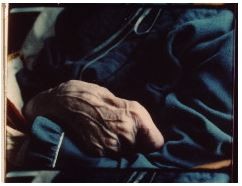
Babji in Nursing Home
Interactive documentary techniques are normally a convention that situates the filmmaker within the historical world that is the film’s referent. In this way reflexivity signifies authorship. It shows the filmmaker’s intervention into the historical world while also signifying the filmmaker’s subjective framing of that world. In the performative mode interactive techniques place greater emphasis on the affective dimensions of experience for the filmmaker. In this way emphasis is placed on how the filmmaker’s subjective position influences his or her emotional disposition. In this sense reflexivity provides one of many gateways to the filmmaker’s emotive state and by implication how this emotive state might influence the construction of the text. Reflexive techniques draw us away from the historical referent and toward the subjectivity and performative characteristics of the film:
“Oh my God. Is that a camera there? Yeah. Are you taking a picture of us lookin’ at the picture? Yeah. Yeah. You’re taking a movie of us watching a movie.“13
In passing through/torn formations interactive techniques draw attention to the performative quality of the filmic text by focussing attention on spectatorship. This seemingly endless loop of representation, “taking a movie of us watching a movie”, returns the referent to the spectator. Spectatorship is all that can exist in such a closed circuit. The spectator is literally the referent, is the subject and the object of subjectivity. With the loop closed ontology lies within the spectator. It can be nowhere else. Hoffman has collapsed the historical world into subjective spectatorship as if to say: Herein lies the truth.
Observational techniques in the performative mode do not assert a capturing of the referential historical world. They accentuate elements of temporal duration, texture and the tactile realm of human experience. As such, it demands an unlearning of traditional documentary spectatorship and its relation to a perceived historical world. This movement can take us easily or uneasily into the realm of the unthought, depending on the representative gesture and the reception of the sign by the spectator. The performative documentary’s rejection of the traditional narrative and disavowal of the ontology of an historical world demands the twin acts of unlearning and the unthought. Unlearning and the unthought are acts that require the mind to split itself in two or more directions at once. Hoffman notes this aesthetico-structural quality in passing through/torn formations: “In order to watch the film you have to split, you have to think in a non-linear way. Because many stories are being told at the same time, the viewer has to choose how to move through it.”14 These performative gestures of unlearning, the unthought and the splitting of the mind become manifest in the eccentric rationalism of Hoffman’s uncle. This uncle believed that his rigorous accordion training as a child, and the inherent bass/melody duality of the instrument, had split his mind in two directions. This split in his mind had left him with “‘manic depressive’ or ‘schizophrenic’ behaviour”.15 It also led Hoffman to incorporate his uncle’s corner mirror as a central metaphor of the film’s abstract narrative:
“He made it because he’d heard someone talk about the left/right brain differences. He felt that when you shave in front of a mirror you’re actually seeing yourself as a reflection – you don’t see yourself as others do. He felt that all the years he’d been shaving helped split him apart, and he could solve this with the corner mirror: two mirrors which reflect into each other. He had to re-learn how to shave because the reflection was the reverse of what he’d grown used to.“16
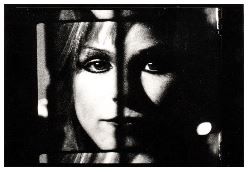
Leesa in ‘corner mirror’
Hoffman’s uncle made another remarkably creative gesture during a stint in prison. He rejigged the circuits of an electric organ such that “the low notes started at the right and left ends of the keyboard: they were symmetrical and moved to a central note in the middle”.17 Of course, the uncle was the only one who could play the peculiar instrument. In this gesture of unlearning and the unthought he had wired the organ so that only he could give it meaning. Like the spectator of the performative documentary, he had become the sole referent.
He was trying to unlearn conventions of the past, the way he’d conditioned himself to live. The moment of creation and transformation is the moment of freeing the moth from the rock. It’s the moment where the image comes to the paper when you’re making a photograph. It’s magical because you’re totally in the present watching what’s becoming. That’s what I got from him, that living instant. . . .18
The implication of the corner mirror is that when you split, you see things differently and you can see yourself as others see you. In other words, to see things from the subjective position of the Other — things as they really are.
passing through/torn formations’ formal structure features multiple fractures in the image, sound and narrative, synchronous enunciation by multiple subjects and multiple signifiers within the frame. One experiences displacement across space and time and the aesthetics of natural and man-made formations and the human subject. Emotions surround the melancholy and horror of human conflict from family disputes to war. Hoffman describes the film as “constructed by way of layering images and sound, through visual superimposition and overlapping of voices on the soundtrack”.19 He interweaves enunciative moments in fragments of narrative cause and effect (as opposed to one dominant linear pulse of narrative cause and effect). He repeats these enunciative moments in a gesture that requires construction of meaning by the spectator. Hoffman describes the effect this way:
“Personas shift in the film as voices become displaced from their original image or context as a result of this shuffling process. The stories reveal themselves as a narrative mosaic rather than the conventional linear narrative flow. This form encourages ambiguity which in turn, I think, leaves space for the viewer’s imagination. It’s as if, in passing through, there is a layer running above and below the film for the viewer to plug into. . . . (as) repetitions of those stories are revealed, the viewer might remember, through an aural or visual clue, something that had preceded it. This allows for a multiple creation of meanings, depending on who’s doing the remembering. . . . I hope (this form) allows the viewer to bring in remembrances from his or her own life. . . . I try to make films that will be open enough for that to happen . . . so that it’s not a closed system and you can bring in things from the outside. . . . It creates a labyrinth of meanings which are connected throughout the film depending on how the individual viewer engages in the piece.“20
In this way the film emphasizes the emotive space that Hoffman has created between spectator and text. It also recalls how Nichols describes the performative documentary: “It proposes a way of being-in-the-world as this world is brought into being through the very act of comprehension, ‘abducted from fragments,’ as Stephen Tyler puts it”.21
The performative documentary lays stress upon the evocative quality of the text rather than any imagined symbiosis with an historical world. With its implicit rejection of ontology of the empirical, the performative documentary requires other ways of evaluating truth within the text. Nichols suggests possible emergent categories in the work of Raymond Williams and Frederick Jameson. Williams’ ‘structures of feeling’ point to “a liminal moment prior to any empirical gesture toward verification”.22 Jameson’s figurability evokes class-consciousness in “vivid and experiential ways” by which “representation finds itself suspended among ‘personal fantasy, collective storytelling, narrative figurability’”.23 Musicologist Simon Frith offers further insights and another possible category. There are striking similarities between Hoffman’s film and musical performance. Filmmaker and musician organize each around a rhythmical performance that structures repetition and layering. Hoffman alludes to this affinity with music in his script:
“I sit beside him and watch from the distance. When he plays there is nothing to say. Just sit and listen, while Polish polka turns to Irish jig, turns to German march, and then a note repeats itself. Again and again. The medley is jazz, reckless, and in its web, all the songs that have ever been played.“24
In musical composition, a fugal texture is a melodic phrase restated in differing keys and at varied intervals. In certain ways passing through/torn formations recalls a fugue.
Simon Frith contends that one’s identity is mobile, “a process not a thing, a becoming not a being,” and that “our experience of music — of music making and music listening — is best understood as our experience of this self in process”.25 Citing John Miller Chernoff’s study of drumming in Ghana, Frith argues that African music is less about representing something than living (the self in process): “The aesthetic point of the exercise is not to reflect a reality which stands behind it but to ritualise a reality that is within it.26 In other words the source of truth in the musical performance can be found in the music itself, in the space between performer and listener. Frith describes how the listener arrives at measuring the performer’s truth to the experience they are representing:
“A good jazz performance, that is to say (like any good musical performance), depends on rhetorical truth, on the musician’s ability to convince and persuade the listener that what they are saying matters. This is not a matter of representation or ‘imitation’ or ideology but draws, rather, on the African-American tradition of ‘signifying’; it puts into play an emotional effect, a collusion between the performer and the audience which is engaged rather than detached, knowing rather than knowledgeable“.27
The appreciation of music provides a way of experiencing the self in process, a way of structuring that experience. As such, it encompasses an ethical agreement between performer and listener. Post-modern music such as hip-hop with its rupture of quotation, scratches, sampling and breaks, is preoccupied with inventive ways of performing texts, in other words performing the production of meaning. Frith argues that this music calls for a form of mutual enactment: “The aesthetic question about this post-modern music, at least, concerns not meanings and their interpretation – identity translated into discursive forms which have to be decoded – but mutual enactment, identity produced in performance”.28
In today’s world dominated by the empirical gesture, it is easy to lose sight of previous times when rhetoric and oratory were much more impassioned pursuits. In the eighteenth century for example, the dividing line between temporal and fine arts was not so rigorous as it has become today. We understand work in the temporal arts as having a momentary existence. Analysis is based on process and a subjective reading based on a contiguous response. The work’s rhetorical qualities (ultimately its signification) lay within that affective response between performer and spectator. This affective response is by its nature, formed by the individual and an infinite number of possible conditions that one can loosely group around the social, historical and material. This defines the performative as a temporal mode that creates a space between performer and spectator that vary across time. Frith sees the temporal ‘echoed’ in Paul Gilroy’s comments on the history of black culture:
“‘The politics of trans-figuration strives in pursuit of the sublime, struggling to repeat the unrepeatable, to present the unrepresentable’. If the politics of fulfilment, in pursuit of rational western politics, seeks to ‘assimilate the semiotic, verbal and textual’, the politics of transfiguration ‘pushes towards the mimetic, dramatic and performative’.“29
We intuitively understand a category of musical ‘truth’ as authentic, as ‘good music’. Musical truth contributes to our ideas about our own identity, “through the direct experiences it offers the body, time and sociability, experiences which enable us to place ourselves in imagined cultural narratives”.30 An aesthetic evaluation (this looks good) is also an ethical determination (this is good). What makes transfiguration important in the construction of identity in the broadest sense is its creation of a space that moves across time (unfettered by empiricism).31 What makes transfiguration important here is that it effectively describes an important rhetorical quality of the performative documentary.
Hoffman describes the non-linearity in passing through/torn formations as a logical evolution of narrative in general. He sees it as a reflection of the way in which people are coming to perceive the world, “sort of like patchwork, with events and memories being associated, but not directly connected nor following logically from one thing to the next as one would experience in a conventional narrative”.32 He might be alluding to the fact that his film’s structuring reflects thought processes not just of himself, but of many others as well. It is a way of seeing that is ‘in the air’, with Hoffman being on the vanguard of those with the skill, creativity and means to articulate it. Hoffman describes passing through/torn formations as a film that had to be made. This description belies an underlying ontological thrust, which recalls Frith’s category of ‘truth’ as music understood as authentic, ‘good music’. Somehow in making a film that had to be made, Hoffman has found a way to repeat the unrepeatable, to present the unrepresentable and reach the sublime.
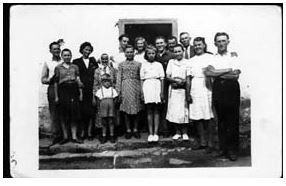
Czechoslovakia 1947, Mom’s Family
passing through/torn formations is a filmic representation of an “inward quest” that Hoffman began upon visiting his mother’s Czechoslovakian birthplace. “I’m trying to reveal that it is okay to have many different ways of looking at the world rather than one singular vision. The blending of forms in Passing Through . . . comes from a fragmenting and gathering back together of all of what I am. A sort of spiritual implosion,” Hoffman said in the interview with Bob Wylkie.33 Hoffman attributes the tangible sense of melancholy in his films to a certain sensibility that Jack Kerouac called ‘a sympathy for humanity’, equilibrium of sadness and joy. Part of the sadness resides in the diasporas, the violence of Western history, its memory and its assiduous threat to surface in an unknown future. Sadness and mystery fill the past in passing through/torn formations with a current of explosive violence shattering the surface in unexplained moments of brutality that echo across time:
“Knuckles hit flesh, saliva dribbles down the white beard, again knuckles hit flesh, six times, blood spitting, after each measured strike. So Karl went out and got very drunk and came back and shot Uncle Janyck seven times. Take your gun and kill him.“34
There is another description of going into an attic and opening a trunk in which Hoffman and his uncle discover the accordion and old photographs. Hoffman’s take on the meaning of this passage is revealing: “I guess that it has to do with the dominant idea that the purpose of photography and film is that it is to tell us something about the past. I think that is too narrow a view, and that, more importantly, photographs and films should be devices that help us get through the present.”35
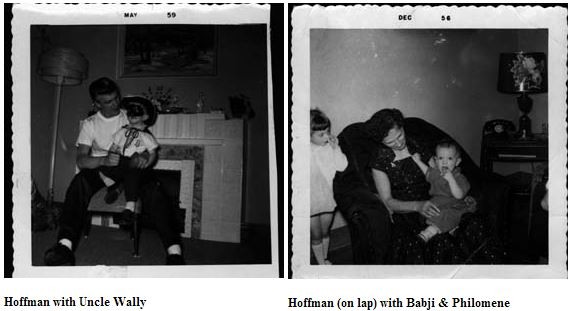
Working through the present, as expressed in Hoffman’s temporal montage, signifies indeterminacy and recalls a discussion by Homi K. Bhabha: “It is a transferential function, ‘whereby the past dissolves in the present, so that the future becomes (once again) an open question, instead of being specified by the fixidity of the past’. . . .”36 Benjamin points to a possible ontology of the discursive object in “the tiny spark of contingency, of the Here and Now, with which reality has seared the subject”.37 The Here and Now could refer to the moment of creation of the discursive object. It could also refer to the moment of reception and brings to mind what Frederick Jameson described as “the power and positive value of situation-specific thinking”.38
The contingency of the Here and Now belies an uncertainty, an implicit disavowal of the empirical and the historical narrative. It is the illumination of the moment that refuses to explain itself through tables, graphs, scientific formulae or historical plots. The world becomes subject to too many variables to be confidently explained; yet one can still intuitively understand it in the illumination of the moment. In this way passing through/torn formations activates uncertainty. Distinguishing family in Canada from Czechoslovakian relatives is difficult, as their identities dislocate and converge. Hoffman has commented that the film functions like the corner-mirror metaphor: “The duality of the piece is that there are two uncles, one in Czechoslovakia, one here in Canada, and they both have difficult stories.”39 Disparate elements blend into one as in a vision or dream, allowing the spectator to construct meaning out of irresolution and incertitude. Hoffman believes that his uncle’s corner-mirror gesture was emblematic of what he is trying to achieve in his films: “Working with conventions, but trying to find new possibilities . . . trying to relocate his way of seeing, to tear away at and question his own vision, the way he’s been taught to see.”40
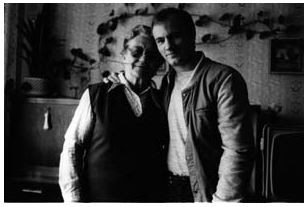
Hoffman with (Czech) Aunt Hanna
PS: All photos were graciously provided by Phil Hoffman.
BIBLIOGRAPHY
Benjamin, Walter. Illuminations. London: Fontana, 1973.
Copjec, Joan ed. Supposing the Subject. London and New York: Verso, 1994.
Foucault, Michel. The Order of Things: An Archeology of the Human Sciences. ed. R. D. Laing New York: Vintage Books, 1973.
Hall, Stuart et al. Culture, Media, Language: Working Papers in Cultural Studies, 1972-79. London: Hutchinson, 1980.
Hall, Stuart and Paul du Gay eds. Questions of Cultural Identity. London: Sage, 1996.
Hoffman, Philip. Unpublished statement, 1987.
Hoffman, Philip, dir. passing through/torn formations. Philip Hoffman, 1988.
Hoffman, Philip. “An Interview with Philip Hoffman on his film passing through/torn formations.” Cantrills Filmnotes 59, 60 (1989): 40 – 50.
Hoolboom, Michael. Inside The Pleasure Dome: Fringe Film in Canada. Toronto: Pages Books, 1997.
Nichols, William. Blurred Boundaries: Questions of Meaning in Contemporary Culture. Bloomington: Indiana University Press, 1994.
Wylkie, Bob. Unpublished Interview with Phil Hoffman. Date Unknown.
[1]Philip Hoffman, unpublished statement, November 1986. Underlining is Hoffman’s emphasis.
[2]Although Hoffman is engaging in a destruction of conventional narrative, he is engaging in the construction of a new form of narrative. This recalls the idea of décollage (destruction/construction) and the interrelatedness hidden beyond the usual destruction versus construction dichotomy.
[3]Philip Hoffman, unpublished statement, November 1986.
[4]William Nichols, Blurred Boundaries: Questions of Meaning in Contemporary Culture, (Bloomington: Indiana University Press, 1994) 92 – 106. All references to performative documentary in this essay refer to these pages of Nichols’ book.
[5]Simon Frith, “Music and Identity,” in Stuart Hall and Paul du Gay, (eds.), Questions of Cultural Identity, (London: Sage, 1996) 108 – 127. I have taken the category of rhetorical truth as it has been applied to music and employed it as an emergent category in performative documentary.
[6]The indexical refers to signs that bear a physical trace to that which they represent, such as a fingerprint, x-ray or photograph.
[7]Philip Hoffman, “An Interview with Philip Hoffman on his film passing through/torn formations,” Cantrills Filmnotes 59, 60 (1989) 41.
[8]Michel Foucault, The Order of Things: An Archeology of the Human Sciences, ed. R. D. Laing (New York: Vintage Books, 1973) 326.
[9]Foucault 327.
[10]Foucault 325.
[11]Michael Hoolboom, Inside The Pleasure Dome: Fringe Film in Canada, (Toronto: Pages Books, 1997) 143.
[12]Hoolboom 143-144.
[13]passing through/torn formations, dir. Philip Hoffman, 1988. (Hoffman’s voice in italics.)
[14]Hoolboom 144.
[15]Hoolboom 144.
[16]Hoolboom 144.
[17]Hoolboom 144.
[18]Hoolboom 144.
[19]Bob Wylkie, Unpublished Interview with Phil Hoffman, 4.
[20]Wylkie 4-5.
[21]Nichols 102.
[22]Nichols 98.
[23]Nichols 98.
[24]Hoffman, passing through/torn formations
[25]Frith 109.
[26]Frith 111.
[27]Frith 117.
[28]Frith 115.
[29]Frith 117-118.
[30]Frith 124.
[31]Although not direct quotes, the previous two sentences borrow extensively from Frith.
[32]Wylkie 6.
[33]Wylkie 16.
[34]Hoffman, passing through/torn formations
[35]Wylkie 11-12.
[36]Homi K. Bhabha, “Anxious Nations, Nervous States,” in Joan Copjec (ed.) Supposing the Subject, (London and New York: Verso, 1994) 212. Bhabha is discussing Kazuo Ishiguro’s The Remains of the Day. His quote is from John Forrester, “Dead on Time,” in The Seductions of Psychoanalysis: Freud Lacan and Derrida, (Cambridge: Cambridge University Press 1990), 206. The idea of intermediacy is elaborated in Bhabha’s The Location of Culture, (London and New York: Routledge 1994).
[37]Benjamin 253.
[38]Nichols 105.
[39]Hoffman, “An Interview with Philip Hoffman…” 41.
[40]Hoffman, “An Interview with Philip Hoffman…” 42.


